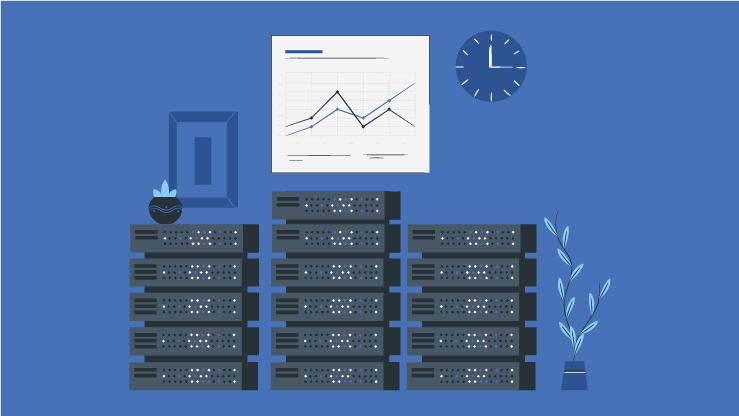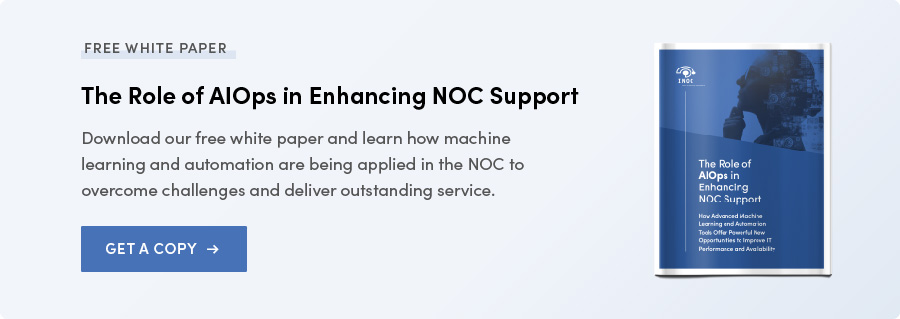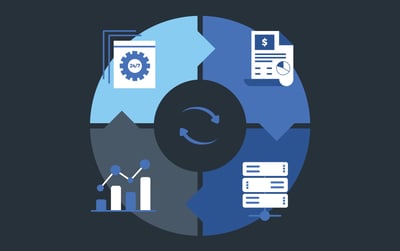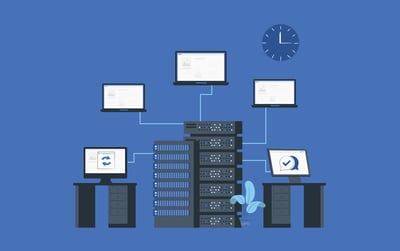Over the last several years, data centers have steadily become more “IT intelligent” environments. Sensors are finding their way into environmental components like HVAC and power systems as well as technical assets like servers, storage, network, and telecommunications equipment.
More communicative devices naturally enable better monitoring. And better monitoring naturally allows for better, faster support, more uptime, and higher overall performance and customer satisfaction. Layer AIOps into this picture and data centers can unlock massive opportunities for alerting, troubleshooting, and incident resolution—driving MTTR way down and MTBF way up.
The traditional approach to monitoring and managing data center infrastructure (i.e., having daytime staff wear various support hats throughout the workday to find and fix faults in between racking equipment) is quickly being replaced by a more thoughtful approach that looks more and more like formalized, 24x7 NOC support.
This new approach takes full advantage of device intelligence and AIOps-powered support workflows to maintain more demanding service levels while freeing staff from the ongoing basic break/fix work that distracts them from critical projects and burns them out over time.
The pull of new monitoring and management technologies also comes with a push from customers who expect their data centers to invest in delivering better, more consistent service. The stakes for 24x7 uptime and performance are only getting higher, and data center customers have adjusted their expectations accordingly.
All of this is prompting data centers to look for IT solutions to remotely monitor and manage their environments—both to make their own lives easier and to unburden internal staff whose time and attention are needed elsewhere.
The question in many teams' minds is this: How do we take all this new device data—and these new alerts—and do something intelligent with them so we can have people in the right spot when incidents do occur while driving down the number of incidents in general?
That's where the modern NOC comes in.
This post briefly explores that opportunity and how we’re helping data center teams seize it to make their lives easier and their customers happier.
The Key Challenges of Data Center Monitoring
Before jumping into the solutions a well-run NOC offers today’s data center, it’s important to lay out the two main challenges we see data centers experience—both of which are solved at their root by well-planned and implemented NOC support: support operationalization and support requirements.
1. Support Operationalization
Because data center teams are typically varied in skillsets/duties and project-oriented by necessity, they can struggle to operationalize their support functions.
Their operational expertise naturally lies in managing the many moving parts of a data center—not in the intricacies of setting up and running a NOC to look after them.
This central operational challenge, as INOC’s Hal Baylor explains, lies at the heart of many of the more top-of-mind challenges data center leaders grapple with day to day, such as which monitoring and ticketing tools are best to use and how they should be configured and integrated with the rest of their toolset and operational workflow.
“If you’re not well-versed with what’s possible in NOC operations today, it might not even dawn on you that you could, for example, feed your alarm system into a ticketing system through an AIOps platform that auto-correlates alarms and gathers rich data for far fewer and far more actionable tickets. Doing that level of solutioning takes NOC experience that wouldn’t make sense to find in most data centers—but that’s exactly the kind of solutioning a NOC service provider like INOC is perfectly suited to provide.”
— Hal Baylor, Solutions Executive, INOC
2. Support Requirements
The other major challenge we encounter with data centers, in particular, lies upstream of the operational questions: what, precisely, requires monitoring and operationalized support in the first place?
- Is it the cross-connect environment (the meet-me rooms with cross-connect ports)?
- Is it the power and environmental components of the data center facility (making sure power is up and what should be done if an alarm indicates a problem)?
- Is it the networking environment (monitoring and managing connectivity between data centers and/or customer environments)?
Typically, a data center’s NOC support needs lie in one or more of these areas, but teams don’t step back to define their support requirements in a way that informs a solution. This step is often rushed and incomplete, creating significant headaches downstream when solutions miss critical needs.
A smart initial step in articulating your specific support requirements is to identify and catalog every component within these categories that require monitoring and a break/fix process be put in place to troubleshoot and restore service in the event of an outage or performance issue.
How the Right NOC Solution Addresses These Challenges
An operationally-mature NOC services partner is well-suited to tackle both challenges and provide value that stretches further into the business.
Let’s take the operational challenge first.
Compared to the months or years it can take to find niche NOC specialists, build a team, draw up an operational blueprint, and bring an operationally mature NOC to life in-house, turning up support with an outsourced NOC service provider gives you instant access to their operational maturity and niche expertise—condensing all that time and effort into just a few weeks—often far more cost-effectively.
Here at INOC, for example, our structured NOC Support Framework radically transforms where and how support activities are managed—both by tier and category. In a matter of months, the value of this operational framework becomes abundantly clear as a client’s support activities steadily migrate to their appropriate tiers while often reducing in volume altogether. This lightens the load on advanced engineers while working and resolving issues faster and more effectively.
Now let’s explore solving the challenge of identifying support requirements.
Any truly effective NOC solution—whether it’s run internally or strategically outsourced—typically starts with a business and technical assessment to paint a complete picture of an organization’s support requirements.
The findings of this assessment determine precisely what the NOC needs to do and help inform the best way to do that. It also paints a clearer picture of what support currently looks like so the forthcoming NOC solution can retain its strengths, improve on its weaknesses, and accomplish its goals as efficiently as possible.
NOC experts who are trained to know what to look for in a business should be the ones stepping back to conduct this analysis and derive support requirements directly from the needs of the business and its customers or end-users. Again, the findings that flow from a well-executed assessment directly inform the NOC’s organization and operationalization across all three essential elements: people, process, and platform.
These questions include:
- What technologies will we need to support?
- Which metrics will we need to measure?
- What volume of work should we expect?
- How demanding will the service levels need to be?
Here at INOC, our business analyses typically include four main components:
- Gathering your support requirements (and/or those of your customers)
- Determining necessary or desired service levels
- Identifying the metrics the NOC will need to measure
- Calculating the total cost of ownership
📄 Read our other guide for a detailed explanation of a NOC business analysis: Building and Setting Up a NOC: The Critical First Steps
How INOC Delivers Next-Level Monitoring and Management Support for Data Centers
Here at INOC, we bring a highly operationalized support platform to plug into and turn up on—giving data centers the ability to take any event or alarm and turn it into a business-intelligent alarm.
What does that mean, exactly?
Once a data center—like any other supported organization—is turned up on our NOC platform, we automatically receive, process, and reference a severity mapping for incoming alarms to prioritize the attention given to them based on the risk they pose to the business. This prioritization helps utilize finite human resources to give the most attention to the most business-critical alarms.
We then take that one step further by layering automation at strategic points in the workflow to trigger (again, based on business criticality) the appropriate action or escalation when necessary.
Our NOC Support Framework typically reduces high-tier support activities by 60% or more simply by effectively categorizing and managing support activities. (Read more on this in our free white paper: Empowering the IT Support Manager.)
When issues do require escalation, automation triggers the necessary notifications to get the right engineer up and moving to the data center even while the extent and cause of a given issue are still being triaged and investigated in the NOC.
"Business-intelligent alarming combined with automation is probably the biggest value-add we bring to data centers because response time to certain events is hyper-critical.”
— Ben Cone, Senior Solutions Engineer, INOC
In short: operationalizing the kind of 24x7 monitoring and support management system the modern data center needs is more than just plugging a ticketing system in. There’s often a long list of technical, operational, and business decisions to make right out of the gate—and an expert NOC partner is perfectly suited to help make good decisions upstream to make life much easier downstream.
📄 Read our comprehensive guide to outsourced NOC support services for a full list of advantages a data center can expect by strategically outsourcing its 24x7 support: The Definitive Guide to Outsourced NOC Support Services
Key Questions for Finding a Data Center NOC Solution
Wondering how much your data center stands to gain from a 24x7 NOC solution? Consider the questions below, and then connect with us for a free NOC consultation to explore your opportunities in depth.
Are you currently using your staff efficiently?
Data centers vary in what DCIM tools they use, but many of these tools don’t bring much of any NOC functionality into the picture; they’re basically asset entities. Even data centers using them well still suffer from break/fix work stealing their staff’s valuable time.
Ask yourself: are your staff doing tasks and watching for faults simultaneously, or do you segment employees into those who monitor infrastructure and smart hands who resolve issues in the facility?
- If network engineers are trying to monitor your environment, manage outages, and complete their daily tasks simultaneously, this might not be the most efficient use of their time, and issues could get missed (while productivity tanks from too much multitasking).
- There may also be a human cost to consider if employees have heavy workloads as a result of understaffing or are unnecessarily stressed by constantly dividing their attention.
Instead, it may be more advantageous to assign dedicated NOC personnel or tap into an outsourcing partner’s shared NOC support model to continuously monitor and manage the infrastructure while your engineers and cable specialists apply their expertise to what they’re best at. (Learn more about dedicated vs. shared NOC support models here.)
No matter which model fits your needs, 24x7 NOC support ensures you’ll be able to detect and respond to events at all hours of the day and night in a timely fashion, even after daytime staff has gone home.
Particularly in a modern data center, with more intelligent monitoring systems focused on precise areas, such as customer rack levels, or measuring temperatures in specific rooms, dedicated experienced engineers are essential to responding in time to meet SLAs.
Do you have the right equipment to respond to incidents and events?
Another consideration is equipment. The more sophisticated your monitoring equipment, the greater the benefit of managing it with equally sophisticated IT operations.
Many data centers struggle with these components of ITOps, bundling together pieces of software together from here and there. In comparison, a seasoned outsourced provider like INOC can simply plug a client’s alert feed into a highly-operationalized support platform and dramatically improve key KPIs like MTTR, MTBF, and TTA while freeing internal staff from monitoring and managing infrastructure.
Acknowledging that some alarms are relatively minor while others are business-critical, INOC’s platform automatically assesses the severity of an alarm in order to identify and prioritize business-critical alarms. This helps us manage resources efficiently and ensure a proper response is elicited, such as notifying a senior-level engineer to drive out to the data center.
When selecting which tools and systems to use, proceed with caution. Look at what other data center companies are using and how successful they’ve been. Consider whether it is a carrier-class tool set and whether you’re equipped to efficiently operationalize it.
What are your SLAs?
Your ideal NOC solution will largely depend on the needs of your customers. For example, if your SLAs require faster response times, this will trickle down into your operational capability needs, ticketing system, and staffing.
Similarly, it’s critical to identify how you need to communicate internally to your departments and externally to customers to support your current service engagements.
For example, how and when do you need to send notifications, or how do you ensure you’re meeting SLAs when it comes to interconnecting data center circuits?
How do you want to manage access control?
Do you need a security guard to control access to your manned data center, or would it be helpful to have a remote provider handle the initial call on an access request and dispatch appropriate personnel to your unmanned data center?
Final Thoughts and Next Steps
When it comes to ensuring your data center monitoring system can meet SLAs and respond to incidents and events, there’s a lot to think about that requires specialized NOC expertise.
From operationalization to staffing and tools, setting up and maintaining an internal NOC that meets your needs 24x7 often requires more time and thought than employees with other duties can sustain. Moreover, purchasing and maintaining the proper equipment and securing experienced staff can be costly.
If you’re looking for a partner that brings all of these capabilities to improve uptime and performance for your business, contact us to see how we can help you improve IT service and NOC support, or download our free white paper below.
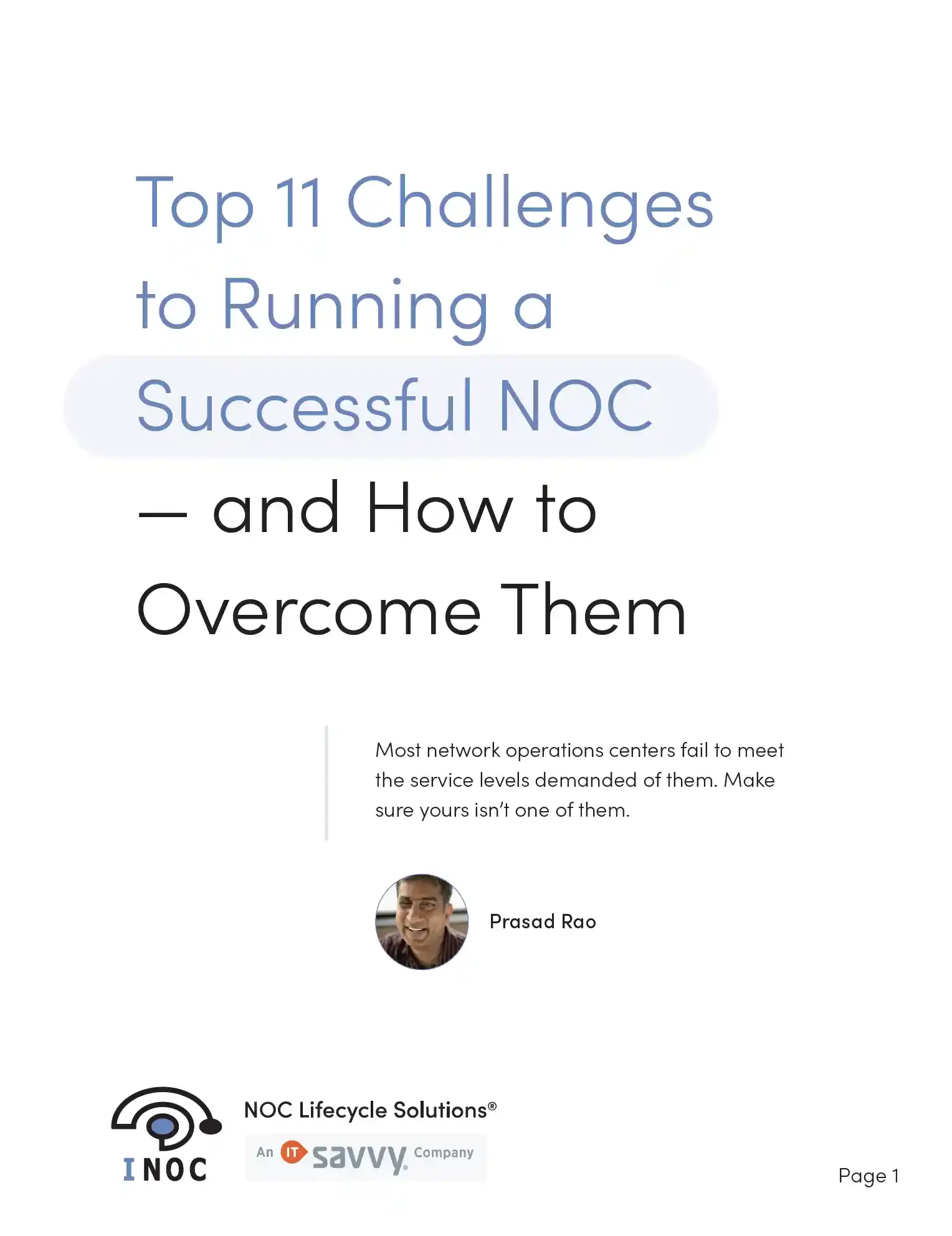
Free white paper Top 11 Challenges to Running a Successful NOC — and How to Solve Them
Download our free white paper and learn how to overcome the top challenges in running a successful NOC.

